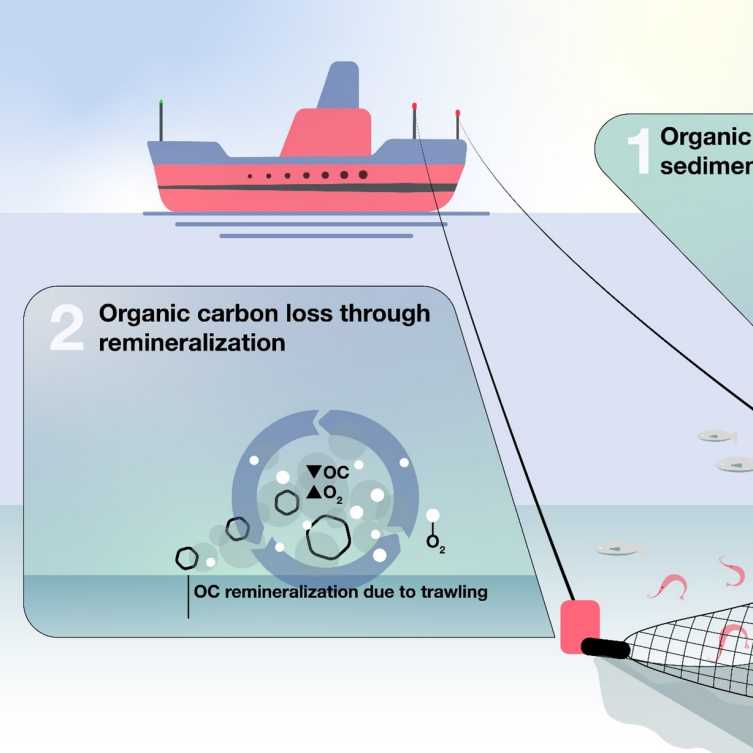New Bachelor's and Master's projects published. Apply now!

Sarah Paradis delves into the secrets of organic carbon sequestration. If you're interested in participating in this Master project, check out our available Bachelor's and Master's projects.
Unlocking secrets of organic carbon sequestration: Evaluating the impact of demersal fisheries on the preservation of organic carbon on the seafloor
Background

Sediment disturbance caused by the contact of bottom trawling gear with the seafloor has the capacity of releasing previously-sequestered sedimentary organic carbon (OC) from the seafloor 1–4. Global models have estimated that bottom trawling could be releasing between 0.2-0.4 Pg·C·yr-1, hampering the capacity of the seafloor of locking away large amounts of OC from the active carbon cycle 5. However, the magnitude of these impacts are highly contested 6–9. This debate is partly due to the different impacts that bottom trawling can have on OC: bottom trawling can resuspend sediment and its associated OC, or enhance its mineralization by oxygenating the sediment layers (Fig. 1).
Method
In August 2024, we collected sediment cores in impacted and control sites to determine the amount of OC that is removed from fishing grounds through erosion and remineralization.
Your tasks:
- Analyze OC content, mineral surface area, δ13C, Δ14C, and 210Pb in these sediment cores.
- Quantify the amount of eroded sediment due to trawling from 210Pb profiles.
- Determine OC stocks in impact and control sites from OC and 210Pb profiles.
- Identify changes in the OC loading in impact and control sites from OC and mineral surface area.
- Identify variations in the OC isotopic composition due to bottom trawling.
- Identify the composition of OC that is preferentially degraded using OC isotopes and mineral surface area.
Further reading
- Paradis, S. et al. Organic matter contents and degradation in a highly trawled area during fresh particle inputs (Gulf of Castellammare, southwestern Mediterranean). Biogeosciences 16, 4307–4320 (2019).
- Paradis, S. et al. Persistence of Biogeochemical Alterations of Deep‐Sea Sediments by Bottom Trawling. Geophys. Res. Lett. 48, (2021).
- Tiano, J. C. et al. Acute impacts of bottom trawl gears on benthic metabolism and nutrient cycling. ICES J. Mar. Sci. (2019) doi:10.1093/icesjms/fsz060.
- Morys, C., Brüchert, V. & Bradshaw, C. Impacts of bottom trawling on benthic biogeochemistry in muddy sediments: Removal of surface sediment using an experimental field study. Mar. Environ. Res. 169, 105384 (2021).
- Sala, E. et al. Protecting the global ocean for biodiversity, food and climate. Nature 592, 397–402 (2021).
- Epstein, G., Middelburg, J. J., Hawkins, J. P., Norris, C. R. & Roberts, C. M. The impact of mobile demersal fishing on carbon storage in seabed sediments. Glob. Chang. Biol. 28, 2875–2894 (2022).
- Paradis, S. et al. Demersal fishery Impacts on Sedimentary Organic Matter (DISOM): a global harmonized database of studies assessing the impacts of demersal fisheries on sediment biogeochemistry. Earth Syst. Sci. Data 16, 3547–3563 (2024).
- Tiano, J. et al. Global meta‐analysis of demersal fishing impacts on organic carbon and associated biogeochemistry. Fish Fish. (2024) doi:10.1111/faf.12855.
- Hiddink, J. G. et al. Quantifying the carbon benefits of ending bottom trawling. Nature 617, E1–E2 (2023).
Contact
Professur für Biogeowissenschaften
Sonneggstrasse 5
8092
Zürich
Switzerland